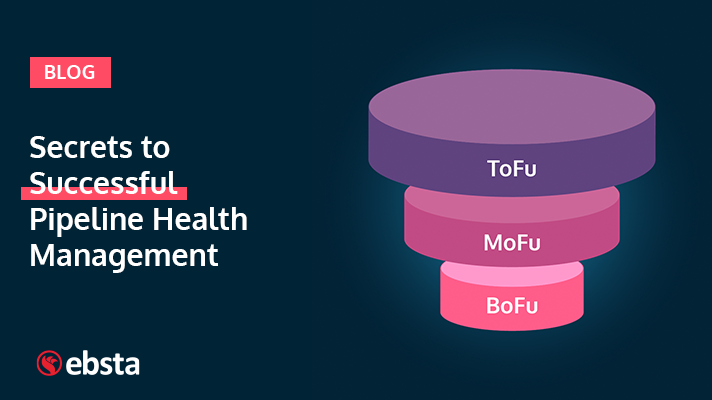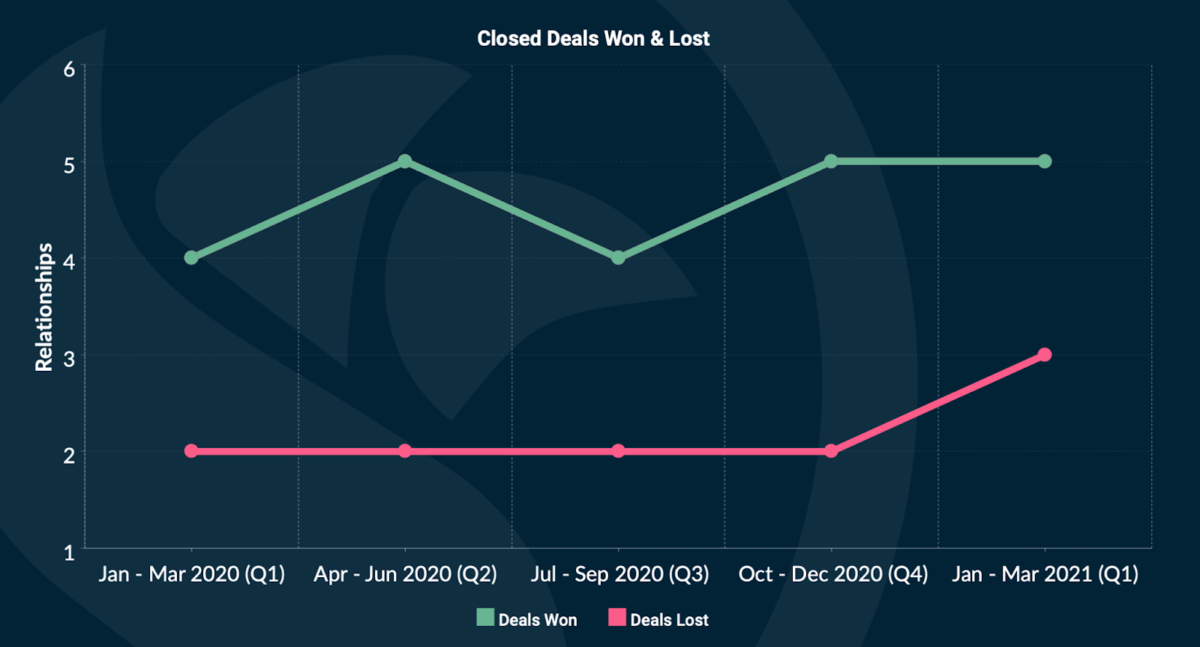Table of Contents
Share this article
Learn from the brightest minds how to predictably and efficiently grow revenue.
Related Content
5 Ways to Use the Ebsta Integration With HubSpot to Improve Sales Performance
How to improve adoption of HubSpot with Ebsta
B2B Sales Benchmarks: 2023 H1 Update
The latest update from the 2023 B2B Sales Benchmarks analysis of over $37bn in pipeline.
How to improve AE quota attainment (according to data)
23% of reps are contributing 83% of revenue. Here's how to solve it (with data)

Secrets to Successful Pipeline Health Management
Table of Contents
What is Sales Pipeline Management?
Sales Pipeline Management is about effectively tracking opportunities from start to finish, all the way through to when they are closed won or lost.
Why is Pipeline Management Important?
Pipeline Health Management allows you to be proactive rather than reactive as it allows you to stay on top of your pipeline in real-time, rather than waiting to lose a deal and question why this has happened. Gaining visibility of each prospect and what stage they are at in the sales journey allows you to anticipate changes in your pipeline so you can be better prepared for the future. Sales reps, as well as leaders, can question whether they are on track to meet their targets and action these insights. This results in an increased likelihood of deals closing. The more deals that close, the more revenue that is generated for your business.
Download our 7 step checklist to understand how to successfully manage your pipeline health.

7 Secrets for Pipeline Health Management
- Track and Review Key Metrics
Sales pipelines are constantly changing and evolving by the day and your key metrics should give you a snapshot of your pipeline health. By keeping track of your key metrics you can scope out what is working well and what could be better. This information can then be leveraged to optimize your sales strategy.
| Metric | Definition |
| Number of Leads per Month | Measures the number of opportunities generated on a monthly basis. |
| Pipeline Value | Measures the expected value of all the qualified opportunities in your pipeline. |
| All of the following metrics are components of sales velocity. | |
| Number of Deals | Measures the number of qualified opportunities in your pipeline. |
| Win Rate | Measures the percentage of opportunities that resulted in a closed won. |
| Average Deal Size | Measures the average revenue generated by closed-won deals over a specific period of time. |
| Sales Cycle | Measures the average time to close for a closed won opportunity. |
| Average Sales Velocity | Measures the speed at which prospects are moving through your pipeline and generating revenue. It can be calculated by multiplying number of opportunities by average deal size and win rate and dividing it all by the length of the sales cycle. |
Michaela Downs, Head of Sales Ops at Benchling, shared her favourite metric on the Sales Ops Demystified Podcast. Michaela also covered how she leverages this metric to strive for operational excellence.
“The sales metric that gives me the most value is sales velocity. It gives me the ability to compare our numbers to everybody else and see what is really happening in our pipeline.”
- Clean Your Pipeline
New leads are added, leads move from one stage to the next, and deals are won. The pipeline is constantly changing and you need to be able to stay on top of this. Regularly update your pipeline to ensure your pipeline reflects what is happening in your business. For example, if an opportunity is stuck in stage too long then close it off as lost and put the contacts into a nurture campaign. When pipeline reviews are conducted this ensures they are as accurate as possible.
- Prioritize Great Looking Late Stage Deals
These deals are late in stage and have lots of activity. They need a final push to get them over the line. You should be questioning what you can do today to close this deal. This step is about creating an action plan which builds an environment of accountability. When reviewing the deals in your pipeline, you can quickly identify what needs to be done to ensure deals that are late in stage are pushed to completion. Strike the iron while it is hot!
- Focus on Advancing Great Looking Early Stage Deals
These deals might be only in the middle stages but you have plenty of activity with them – so how can you accelerate these deals to a close? Understanding the buyer’s main pain point can help you to close deals faster. Take the time to map out exactly what you want the buyer’s journey to look like. When creating this road map, refer back to this main pain point for every single step. Lead with solutions!
Many sales reps find the length of sales cycles to be the biggest barrier for them to overcome. As previously mentioned, customers have more choices than ever which means the longer the sales cycles, the more opportunities customers have to explore and choose alternative products. Moral of the story? Short and sweet wins the race.
- Address Risks
These deals are maybe middle or late in stage, but they are not the shining lights in your pipeline, they have a number of issues that need addressing. Identify the deals in your pipeline at risk and create a plan of attack to get them back on track. Focusing on these can be the difference between just missing your goals, and smashing your business targets. It may be that they only have some activity – but are far from being full of strong relationships. So what constitutes a strong relationship?
A strong relationship involves having relationships with multiple stakeholders on an account. One way to measure the strength of your relationships is through the Ebsta Score. This considers total activity count and days since last activity, but it also looks at the type of activity, its direction (inbound/outbound), duration and timing to derive a single engagement percentage metric.
- Kill Dead Leads or Create Action Plans
What does a high-risk deal look like? These are deals with poor engagement and low levels of activity that are late in stage. There are 60% fewer relationships in closed lost deals and the ideal number of relationships resulting in closed won deals is 4 to 5 relationships. By identifying and prioritizing opportunities that are at high risk, you can take back control of your deals by increasing the amount of activity and engagement with that opportunity. This increases the likelihood of pushing the deal towards a closed-won rather than a closed lost.

Which deals have been in a stage too long? Which are likely to close before the end of the quarter? Which have such low levels of engagement that you need to cut them loose? Knowing when to give up or let go of a dead lead can be difficult especially if you have been building a relationship with them over a long period of time. Remember, getting rid of deadweight can make room for highly qualified leads which are more likely to close and create revenue for your business. How do you identify qualified leads?
One way to do this is by using the Deal Score which provides you with a score between 1 and 100 on how likely a deal is to close. Reps and managers can then sort deals by using this score to prioritize which deals to focus on and coach reps accordingly.
Some leads need more nurturing than others hence they won’t close in the current quarter. In this situation, you should not remove these leads from your pipeline. Instead, shift them into your next quarter and plan what steps you will take when that time comes.
- Nurture Early Stage Deals
Lastly, at the end of the quarter, review early stage deals and identify next steps to progress them forward. These deals will need nurturing to progress, so now ask yourself what can be done to advance your deal to the next stage. This is the time to prioritize your key deals, whether that is by size of deal, company, account grade or a lead or intent score. Then start building strong relationships with multiple stakeholders at those key accounts. Keep the lines of communication open and frequent.
Customers have access to more options than ever before. They are easily able to compare two products by reading up on reviews, asking questions on community forums or by directly contacting customer service. Competition is fierce and you want to be able to stand out from the crowd and building and nurturing relationships with leads will help you to do just that. It can be hard to keep track of every lead and remember to follow up with each of them, especially when there are multiple stakeholders involved. However, keeping track of engagement can remind you to follow up with every single one of your leads.
Take a new approach to your pipeline health management in 2022 that will help you to prioritize the deals that matter most, close deals faster, improve your pipeline management processes and create accountability.
Now we have discussed the 7 secrets to managing your pipeline health, here is a checklist you can keep on hand when conducting your next pipeline review. We covered the why and here’s the 7-step checklist covering the HOW of managing your pipeline health.



